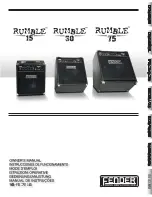
Page 33 of 44
P/N 595236-01 Rev. B 10/11
CAUTION
DO NOT LEAVE THE CYLINDER VALVE OPEN
WHEN THE RESPIRATOR IS NOT IN USE.
LOCKING
TAB
FIGURE 16
Locking tab mechanism
8. Replace with a fully charged cylinder and valve assembly of the
same pressure rating. Slide the top of the cylinder upward under the
strap.
9. Engage the cylinder hanger in the hook at the bottom of the back-
frame.
NOTE
FOR 4500 PSI RESPIRATORS: IF A DIFFERENT DURATION OR DIAM-
ETER CYLINDER IS USED, USE THE TRI-SLIDE BUCKLE TO ADJUST
THE RETENTION STRAP SO THAT IT PRESSES TIGHTLY AGAINST
THE CYLINDER WHEN THE LATCH ASSEMBLY IS FULLY ENGAGED.
THE USER SHOULD NOT BE ABLE TO MOVE RETENTION STRAP UP
AND DOWN ON THE CYLINDER WITH THEIR FINGERS WHEN THE
LATCH ASSEMBLY IS FULLY CLOSED.
10. Secure the cylinder in place by pushing the latch toward the back-
frame to lock the cylinder latch and fully engage the cylinder latch
assembly.
NOTE
ENSURE THAT THE CYLINDER IS SECURELY HELD IN PLACE ON THE
BACKFRAME BY THE CYLINDER RETENTION ASSEMBLY. DO NOT
USE EXCESSIVE FORCE TO LOCK THE LATCH MECHANISM. IF THE
RETENTION STRAP IS TOO TIGHT OR TOO LOOSE, USE THE TRI-
SLIDE BUCKLE TO ADJUST THE RETENTION STRAP ENGAGEMENT
LENGTH, THEN RE-ATTEMPT TO ENGAGE THE LATCH ASSEMBLY.
11. Inspect the high pressure coupling and verify that the gasket seal is
present and undamaged. See FIGURE 17.
If the gasket is present and undamaged, align the high pressure
coupling with the outlet of the cylinder valve and tighten the hose
coupling to the cylinder valve by hand.
12. The respirator is ready for continued use. See the PREPARATION FOR
USE section of this instruction and USE OF THE RESPIRATOR section
of this instruction. If respirator use is not continued, the respirator must
be cleaned and inspected. See the CLEANING AND STORAGE section
of this instruction.
13. The removed cylinder shall be inspected and refilled by authorized
personnel. See SCOTT
Specialist Level Maintenance Module
s, avail-
able on request from SCOTT Safety, for further information.
CAUTION
ALWAYS CLOSE THE CYLINDER VALVE ON
"EMPTY" CYLINDERS. AN OPEN VALVE MAY
ALLOW MOISTURE OR OTHER CONTAMI-
NANTS TO ENTER THE CYLINDER.
CAUTION
WRENCHES SHALL NOT BE USED TO TIGHT-
EN THE HOSE COUPLING. OVER TIGHTEN-
ING THE HOSE COUPLING MAY DAMAGE
THE GASKET SEAL.
WARNING
USE OF A RESPIRATOR WITH A MISSING
OR DAMAGED COUPLING GASKET MAY RE-
SULT IN AIR LEAKAGE WHICH MAY REDUCE
THE DURATION OF USE AND/OR THE TIME
REMAINING AFTER THE END OF SERVICE
ALARM ACTUATES OR MAY PREVENT THE
END OF SERVICE ALARM FROM ACTUATING.
THE USE OF A RESPIRATOR WITH SUCH
AN AIR LEAK MAY RESULT IN EXPOSURE
OF THE USER TO THE ATMOSPHERE THE
RESPIRATOR IS INTENDED TO PROTECT
AGAINST WHICH MAY LEAD TO SERIOUS
INJURY OR DEATH.
CYLINDER REPLACEMENT
CONTINUED ON NEXT PAGE...
FIGURE 17
High pressure
gasket seal
HIGH PRESSURE
GASKET SEAL












































